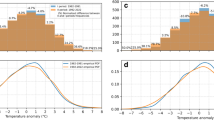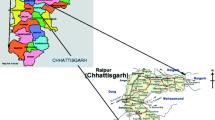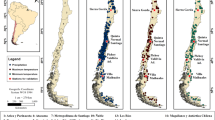Abstract
This study presents a spatial clustering of precipitation in Iran based on gridded data from the Precipitation Climatology Centre from 1951 to 2007. After standardizing the data, two multivariate methods of factor analysis and cluster analysis were used to derive primary homogeneous regions. Then, two statistical tests based on the concepts of L-moments were applied to examine the homogeneity of clusters and the discordancy of their member(s). Next, the geographical similarities of different parts of Iran were considered to move heterogeneous points to other clusters. These two steps were repeated to derive clusters that passed both tests. Finally, for each final cluster (region), the best probability distribution function was determined for frequency analysis. The results showed that, in terms of precipitation, Iran can be categorized into eight main probabilistic homogenous regions, and the Wakeby probability distribution function was chosen for half of them.






Similar content being viewed by others
References
Akhter Y, Mahsin MD, Mohaimin MZ (2012) An application of factor analysis gross domestic product data of Bangladesh. Bangladesh e-J Sociol 9(1):6–18
Alijani B, Harman TR (1985) Synoptic climatology of precipitation in Iran. Ann Assoc Am Geogr 75(3):404–416
Alijani A, O’Brien J, Yarnal B (2008) Spatial analysis of precipitation intensity and concentration in Iran. Theor Appl Climatol 94:107–124. doi:10.1007/s00704-007-0344-y
Boyacioglu H, Gunduz O (2005) Application of factor analysis in the assessment of surface water quality in Buyuk Menderes river basin. Eur Water 9(10):43–49
Burn DH, Goel NK (2000) The formation of groups for regional flood frequency analysis. Hydrol Sci J Sci Hydrol 45(1):97–112
Dezfuli AK (2011) (2011) Spatio-temporal variability of seasonal rainfall in western equatorial Africa. Theor Appl Climatol 104:57–69. doi:10.1007/s00704-010-0321-8
Dezfuli AK, Karamouz M, Araghinejad S (2010) On the relationship of regional meteorological drought with SOI and NAO over southwest Iran. Theor Appl Climatol 100:57–66
Di Balldassarre G, Castellarin A, Brath A (2006) Relationships between statistics of rainfall extremes and mean annual precipitation: an application for design-storm estimation in northern central Italy. Hydrol Earth Syst Sci 10:589–601
Dinku T, Connor SJ, Ceccato P, Ropelewski CL (2008) Comparison of global gridded precipitation products over a mountainous region of Africa. Int Climatol 11:2960–2979
Dinpashoh Y, Fakheri-Fard A, Moghaddam M, Jahanbakhsh S, Mirnia M (2004) Selection of variables for the purpose of regionalization of Iran’s precipitation climate using multivariate methods. J Hydrol 297:109–123
Fernandez Mills G (1995) Principal component analysis of precipitation and rainfall regionalization in Spain. Theor Appl Climatol 50:169–183
Heise B, Bobertz B, Harff J (2010) Classification of the Pearl River estuary via principal component analysis and regionalization, J Coast Res, pp.769- 779
Hosking JRM, Wallis JR (1991) Regional frequency analysis using L-moments. Research Rep. Watson Research Center, IBM Research Division, Yorktown Heights
Hosking JRM, Wallis JR (1993) Some statistics useful in regional frequency analysis. Water Resour Res 29(2):271–281
Hotelling H (1933) Analysis of a complex of statistical variables into principal components. J Educ Psychol 24(417–441):498–520
Johnson RA, Whichern DW (1992) Applied multivariate statistical methods, Third Edition. Prentice Hall
Johnson RA, Whichern DW (2002) Applied multivariate statistical analysis. Prentice Hall Inc., Upper Saddle River, NJ07458
Kaiser HF (1960) The application of electronic computers to factor analysis. Edu & Psych Meas 20:141–151
Kaiser HF (1970) A second generation little Jiffy. Psychometrika 35(4):401–415
Kaiser HF, Rice J (1974) Little Jiffy Mark IV. Educ Psychol Meas, Vol. 34. No. 1
Kim JO, Mueller CW (1978) Factor analysis: statistical methods and practical issues. Sage Publications, Beverly Hills, Calif, HA29.Q35/VOL 14
Kumar R, Chatterjee C (2005) Regional flood frequency analysis using L-Moments for north Barhamputra region of India. J Hydrol Eng ASCE 10:1–7
Liu C-W, Lin K-H, Kuo Y-M (2003) Application of factor analysis in the assessment of groundwater quality in a black-foot disease area in Taiwan. Sci Total Environ 313:77–89
Martins DS, Raziei T, Paulo AA, Pereira LS (2012) Spatial and temporal variability of precipitation and drought in Portugal. Nat Hazards Earth Syst Sci 12:1493–1501
Marzban C, Sandgathe S (2005) Cluster analysis for verification of precipitation fields. Weather Forecast 21:824–838
Modarres R (2008a) Regional frequency distribution type of low flow in North of Iran by L-Moments. Water Res Manage 22:823–841
Modarres R (2008b) Regional maximum wind speed frequency analysis for the arid and semi-arid regions of Iran. J. Arid. Environ. 1329–1342
Modarres R, Sarhadi A (2011) Statistically-based regionalization of rainfall climates of Iran. Glob Planet Chang 75:67–75
Raziei T, Bordi I, Pereira LS (2008) A precipitation-based regionalization for Western Iran and regional drought variability. Hydrol Earth Syst Sci 12:1309–1321
Raziei T, Bordi I, Pereira LS (2011) An application of GPCC and NCEP/NCAR datasets for drought variability analysis in Iran. Water Resour Manage 25:1075–1086. doi:10.1007/s11269-010-9657-1
Raziei T, Bordi I, Pereira LS, Sutera A (2010) Space-time variability of hydrological drought and wetness in Iran using NCEP/NCAR and GPCC datasets. Hydrol Earth Syst Sci 14:1919–1930
Raziei T, Daryabari J, Bordi I, Pereira LS (2014) Spatial patterns and temporal trends of precipitation in Iran. Theor Appl Climatol 115:531–540. doi:10.1007/s00704-013-0919-8
Raziei T, Saghafian B, Paulo AA (2009) Spatial patterns and temporal variability of drought in western Iran. Water Resour Manage 23:439–455. doi:10.1007/s11269-008-9282-4
Reyment RA, Joreskog KG (1996) Applied factor analysis in the natural sciences. Cambridge University Press
Schneider U et al. (2013) GPCC’s new land surface precipitation climatology based on quality-controlled in situ data and its role in quantifying the global water cycle. Theor Appl Climatol
Serrano A, Garcia JA, Mateos VL, Cancillo ML, Garrido J (1998) Monthly modes of variation of precipitation over the Iberian Peninsula. J Clim 12:2894–2919
Serrano SM, Moreno JL (2005) Hydrological response to different time scales of climatological drought: an evaluation of SPI in a mountainous Mediterranean basin. Hydrol Earth Syst Sci 9:523–533
Singovszka E, Balintova M (2012) Application of factor analysis for evaluation surface water and sediment quality. Chem Eng Trans 26:183–188
Soltani S, Modarresa R, Eslamian SS (2007) The use of time series modeling for the determination of rainfall climates of Iran. Int J Climatol 27:819–829. doi:10.1002/joc.1427
Tortorelli RL, Rea A, Asquith WH (2005) Depth-duration frequency of precipitation for Oklahoma, USGS. Water Resour Invest Rep 99-4232
Yurekli K, Modarres R, Ozturk F (2009) Regional maximum rainfall estimation for Cekerec watershed by L-moments. Meteorol. Appl. 435–444. dx.doi.org/10.1007/s00704-013-0860-x.
Author information
Authors and Affiliations
Corresponding author
Rights and permissions
About this article
Cite this article
Sarmadi, F., Shokoohi, A. Regionalizing precipitation in Iran using GPCC gridded data via multivariate analysis and L-moment methods. Theor Appl Climatol 122, 121–128 (2015). https://doi.org/10.1007/s00704-014-1292-y
Received:
Accepted:
Published:
Issue Date:
DOI: https://doi.org/10.1007/s00704-014-1292-y




